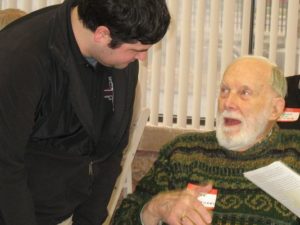 Ever wondered about the stories of the people buried in Beech Grove Cemetery?
Ever wondered about the stories of the people buried in Beech Grove Cemetery?
Last week, some of those stories were recorded for all to enjoy and to learn about some of the people buried at the historic cemetery.
For example, did you know that Elizabeth Claypool served on a library board in the late 1800s when the first building built as a library was constructed? Muncie Public Library director Ginny Nilles recorded that story, and another about a relative, Austin Claypool, who served in Parliament in Alberta, Canada, and later on the county council in Delaware County.
There’s also the story of Rev. Oliver Carmichael as told by John “Jack” Carmichael Jr., himself a well-known person in the Muncie community, active in public office. Oliver enlisted as a corporal in the Union Army in July 1861 during the Civil War. He suffered a gunshot wound to his leg in July 1863. Upon his discharge, he came home, married and was elected to four terms as state representative from Muncie. He introduced the first women’s suffrage bill. He died in 1924.
Last Thursday, about 15 people from the community filled the offices at the Beech Grove with the sound of history as they enjoyed refreshments and told others stories of their ancestors. They also sat down at small tables with tape recorders and recorded histories of some of the people, often relatives, buried in Beech Grove.
The history project was spearheaded by the Beech Grove board because members wanted to preserve some of the history of the nearly 44,000 buried there. Obviously, the dead cannot speak, so the next best thing was done; family members could record the stories of their ancestors.
Ronald Morris, professor of history at Ball State University, took on the project and made it part of an immersive education experience for three students. A grant from the George and Frances Ball Foundation helped make the project a reality.
Morris said a new team of students will compile the stories this summer and develop a walking tour and app for visitors to use. In the fall, another team of students will publish a book for online and print consumption.
Why is this project important? Morris explained that history serves as a guidepost for the community, and that it’s important for people to know who was here before. It also indicates what the community believes is important to remember, as well as bringing to light stories and people previously unknown.
With the efforts of those taking part in this project, those stories won’t remain hidden for long.
Source: The Star Press
